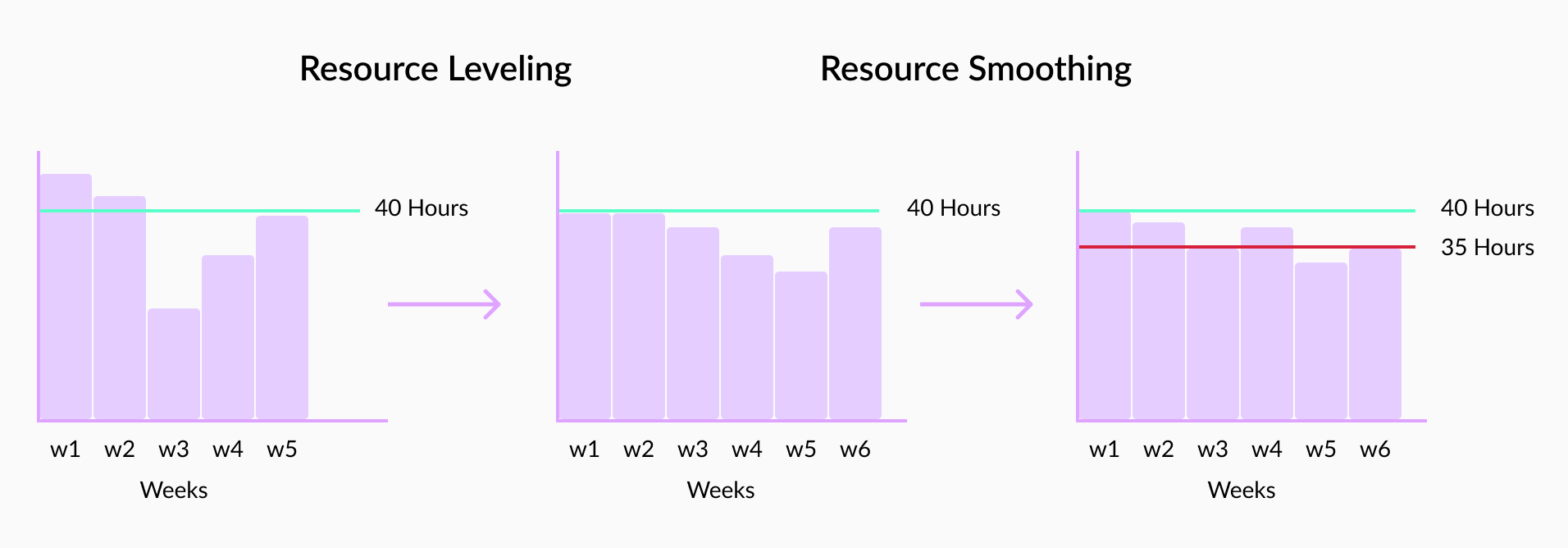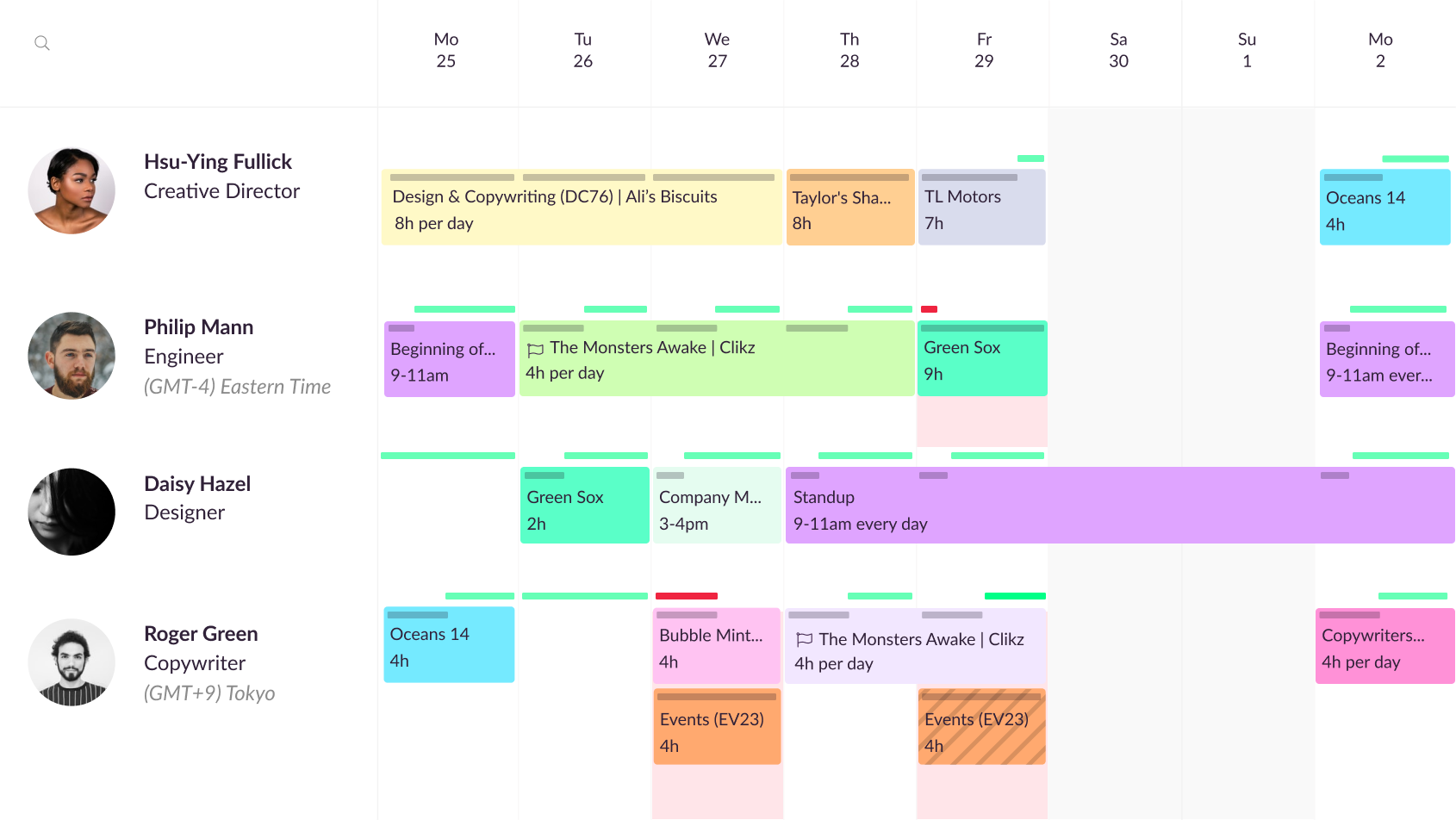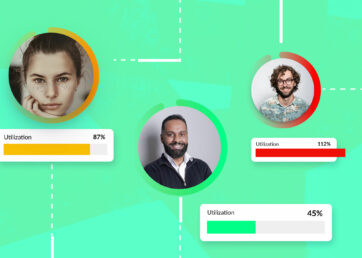As a project manager, you’ve probably had the iron triangle of project management drilled into your brain: balancing the budget, scope, and schedule of projects to make projects as high-quality as possible.
That may sound simple on paper, but in reality, resource management is one of the top three challenges facing project management offices (PMOs), according to Wellingtone’s 2021 State of Project Management Report.
The key to better resource management (and a strong ROI) is the ability to maintain an optimal combination of the time spent on billable tasks and downtime. And the overlooked key to that balancing act? Mastering resource utilization.
In this article 📖
What is resource utilization and how is it different from resource allocation?
Even if you’ve been in the project management field for a while, it’s easy to mix up resource allocation and resource utilization because they’re intertwined. Let’s break it down.
Resource allocation
Resource allocation is how you strategically assign available resources to projects where they have the highest chance of success. This involves considering individual employee skillsets, workloads, and schedules. You also need to think about who they work with the best.
Imagine you’re planning a surprise party. If two of your friends volunteered to bake a cake, effective resource allocation would be choosing the friend who owns a bakery instead of the friend who is an interior designer. But you could ask the interior designer to help decorate.
Resource utilization
Resource utilization is the way you measure how well you distribute those resources, comparing the hours spent on billable and non-billable work. Effective resource utilization plays a huge factor in project quality. Most experts agree that the “sweet spot” is hitting around 70-80% utilization. Then, employees have 20-30% of their available time left over for areas like continuing education, creativity, or well-deserved breaks.
The key is preventing overutilization or underutilization. If you over-utilize, you risk the project not getting done on time or done well. You also increase the likelihood of employee burnout or even turnover.
Going back to party planning, if you asked your baker friend to make a cake and cupcakes and donuts, they might get overwhelmed and burn the cake or come late to the party. And if you had the baker split responsibilities with the interior designer friend (who they didn’t get along with), that’s another recipe for disaster.
On the flip side, if you underutilize, you risk missing deadlines. You might also end up with frustrated employees if you have to suddenly pull them off one project to work on another. So, if you told the interior designer you didn’t need any help, you might find yourself putting up decorations while guests are walking in. If you called your friend an hour before, because you realized you do need their help, they might agree but be annoyed that they don’t have time to run errands beforehand.
Balanced resource utilization improves job performance and satisfaction
Resource utilization impacts everything from employee morale to your ability to effectively plan resources for the future. When resources are utilized well, you’ll notice positive short- and long-term project success that adds business value.
To be an expert at resource utilization, you need to be an expert at resource leveling and resource smoothing. Consider resource leveling as the foundation: reviewing individual employee workloads and adjusting to make sure they aren’t scheduled over capacity.

Resource smoothing is the next level. This is where you evaluate employee workloads as well as time off, then take that information to build in a “buffer zone,” or time without assigned projects. This downtime minimizes employee disengagement, burnout, and turnover by preventing overutilization.
It also helps you as a project manager. Employees will have extra bandwidth, which makes it easier to find additional coverage for projects if something unexpected comes up.
Employee satisfaction regarding both their job and salary was the highest among people who said they had neither too little nor too much downtime.— Paychex Worx study
Investing in improving resource utilization is also an investment supporting the bottom line. Burnout costs companies a staggering $120-190 billion annually, and a study by Gallup found a 23% difference in profitability between businesses with the highest and lowest employee engagement rates. Job satisfaction is extra important amid the Great Resignation, when it’s more difficult to attract and retain employees.
Effective resource utilization also makes your life easier as a project manager. Here are four reasons why:
- You’ll be more proactive and less reactive in your project staffing. This means less frustration for employees and clients and fewer changes to planned budgets.
- Employees are less likely to call off unexpectedly or resign. When employees are in a good place, you don’t have to worry as much about scrambling to meet new staffing needs or pushing deadlines back.
- You’ll be more confident when planning future projects and budgets. When you’re meeting your resource utilization targets, you know your resource planning is sound. This gives you more peace of mind when determining how to meet future billable projects.
- Employees will be more productive and will put out higher-quality work. According to research from the University of Oxford, “happy workers are 13% more productive.” And when employees can commit fully to projects instead of switching between them, they’ll be able to fully concentrate on doing their best work.


“Resource Guru is simple to use. It allows us to optimize our resources and keeps an eye on every project.”
Be more strategic by applying resource utilization formulas
As the saying goes, you can’t manage what you don’t measure. Calculating resource utilization rates will give you objective data to support how to improve productivity. If you don’t track these metrics, you have to base these important decisions on educated guesses — which will have the opposite effect you want on both productivity and profitability.
Calculating individual utilization rates
What it’s for: You want to find out how effectively a single employee is being utilized.
How to calculate it: You want to find out copywriter Jason’s utilization rate for the upcoming week. He has a standard 40 hour week planned and is booked on billable tasks for 30 hours. You’ll simply divide his total working hours (30) by the total number of hours he’s available (40).
(Total working hours ÷ Total hours available) x 100
Divide 30/40, which equals .75. Then multiply by 100. Kudos — that’s a 75% utilization rate.
Calculating organizational utilization rates
What it’s for: You want to find out the average resource utilization rate across all employees.
How to calculate it: You work at a small marketing agency with 7 employees. First, you’ll calculate each individual utilization rate and add them together. Then, you’ll divide that sum (575) by the total number of employees (7). Multiply by 100 for an organizational utilization rate of 82.1%.
(Total individual utilization rates ÷ Total number of employees) x 100
Calculating target billable rate
What it’s for: You want to know what your company should charge for hourly pricing to cover expenses while still making a profit.
How to calculate it: We’ll stick with our 7-employee team for this example.
Average salary + overhead per employee + target profit margin
÷ Average billable hours worked
÷ Organizational utilization rate
To get the top line in this calculation:
- Add up each employee’s salary and divide by 7 to get your average salary cost
- Add that number ($50,000) to the average amount of overhead per employee (e.g., $10,000)
- Take that new sum and multiply it by your ideal profit margin to get your target margin in dollars ($60,000 x .15 = $9,000)
- Add the three numbers together ($50,000 + $10,000 + $9,000 = $69,000)
- To get the bottom number in the fraction
- Add up how many hours each employee spends on billable work annually
- Divide by 7 to get the average billable hours (let’s say 2,100)
- Then, divide $69,000 by 2,100 for a total of $32.85.
- Take that $32.85 and divide it by your organizational utilization rate — we calculated this in the previous section already, so we know it’s .821. You’ve got a target billable rate of $40.01.
Phew!
Calculating target utilization rates
What it’s for: You want to improve your organizational utilization rate to make sure you’re able to sustain your target billable rate.
How to calculate it: Make sure you calculate your target billable rate before you try to calculate your target utilization rate. In doing so, we already have the top number for the fraction ($69,000), the average billable hours worked (2,100), and the target billable rate ($40.01).
Average salary + overhead per employee + target profit margin
÷ (Average billable hours worked x target billable rate)
So, we just plug the numbers in and, voila!
If your company wants to stick with a $40.01 billable rate, employees would need to be utilized at 82% to cover overhead and make a 15% profit. Since that’s slightly higher than the recommended utilization zone, you could play around and see what reasonable billable rate would bring it down to no more than 80%.
How resource management software helps you prevent ineffective utilization
Trying to calculate and monitor resource utilization rates using a manual tool like a spreadsheet is time-consuming and difficult. Resource management software saves you time and gives you more confidence in the accuracy of your employee data. This helps you make more decisions that support optimal resource utilization.
With clear, comprehensive visibility into workloads and resource availability, a resource management system is a great asset to help you stop overutilizing and underutilizing. And because the data updates in real-time, you can create stronger resource forecasts for new projects. The same can’t be said for manual tools like spreadsheets — 88% of them have at least one error.
Because resource management software houses all your information on full-time and freelance employees in one place, you don’t have to bounce between multiple sources of data. And all the key details are placed up front in a dashboard, so you can clearly see what each employee’s projects, their current capacity, and their upcoming capacity looks like. This makes it easier to spot potential issues and opportunities and adjust workloads accordingly in your project plan.

Resource Guru also includes a handy feature that lets you put an overbooked employee on a waiting list. If their calendar opens up, then that employee is automatically put on the project.
Resource management tools take a lot of the leg work out of determining resource capacity levels and tracking scheduled billable utilization and non-billable hours, unscheduled time, and total available hours. It then uses that information to automatically calculate your team’s utilization rate. That’s less math for you! And you’ll immediately see how workload adjustments impact resource utilization.
All this information can be turned into a strategic utilization report with a few clicks. According to Wellingtone, 50% of project managers currently spend at least one day manually compiling reports. When you get that time back, you can concentrate more on analyzing your reports to come up with data-backed resource utilization plans. These actions will translate to happier employees, clients, and executives.
Strategic resource utilization is about putting your people first
Take the first step to make sure your team members have a sustainable balance of work and play by calculating individual and organizational utilization rates. From there, you can make tweaks that’ll improve productivity, morale, and the bottom line. Everybody wins, from the staff to the C-suite!
To take your resource utilization game to the next level, check out Resource Guru’s capacity planning software.






